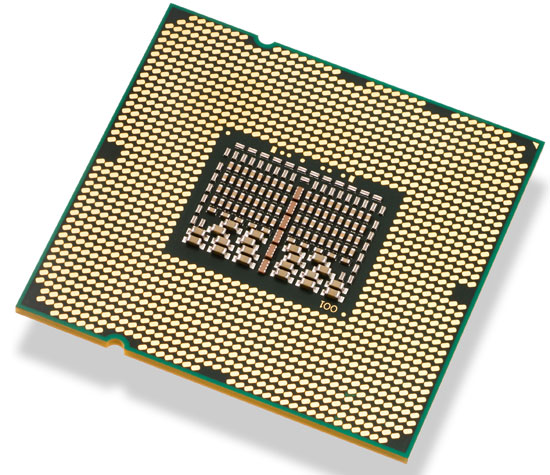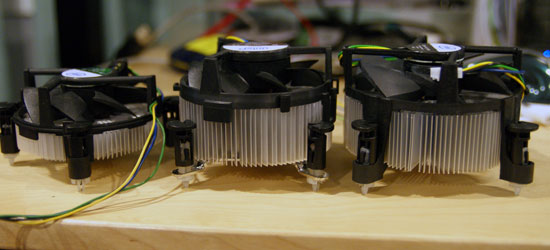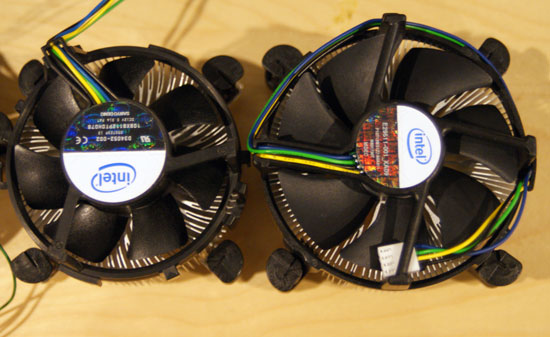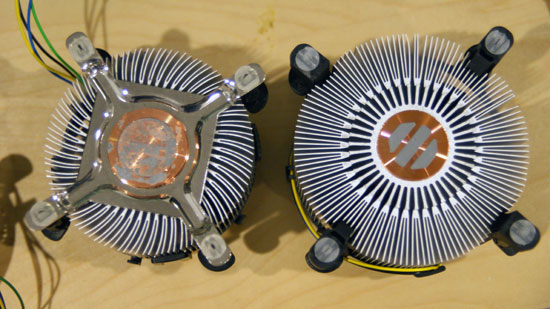The Dark Knight: Intel's Core i7
by Anand Lal Shimpi & Gary Key on November 3, 2008 12:00 AM EST- Posted in
- CPUs
The Chips
With a new microarchitecture comes a new naming system and while it makes sense for Intel to ditch the Duo/Quad suffixes that's about the only sensible thing that we get with Nehalem's marketing. The new name has already been announced, Nehalem is officially known as the Intel Core i7 processor. Model numbers are back of course and the three chips that Intel is announcing today are the 965, 940 and 920. The specs break down like this:
| Processor | Clock Speed | QPI Speed (GT/sec) | L3 Cache | Memory Speed Support | TDP | Unlocked? | Price |
| Intel Core i7-965 Extreme Edition | 3.20GHz | 6.4 | 8MB | DDR3-1066 | 130W | Yes | $999 |
| Intel Core i7-940 | 2.93GHz | 4.8 | 8MB | DDR3-1066 | 130W | No | $562 |
| Intel Core i7-920 | 2.66GHz | 4.8 | 8MB | DDR3-1066 | 130W | No | $284 |
Obviously there's no changing Intel's naming system now, but I'd just like to voice my disapproval with regards to the naming system. It just doesn't sound very good.
These chips aren't launching today, Intel is simply letting us talk about them today. You can expect an official launch with availability by the end of the month.
The Socket
By moving the memory controller on-die Intel dramatically increased the pincount of its processor. While AMD's Phenom featured a 940-pin pinout, Intel's previous Core 2 processors only had 775 contact pads on their underside. With three 64-bit DDR3 channels however, Intel's Core i7's ballooned to 1366 pads making the chip and socket both physically larger:

The downside to integrating a memory controller is that if there are any changes in memory technology or in the number of memory channels, you need a new socket. Sometime in 2009 Intel will introduce a cheaper Nehalem derivative with only a 2-channel memory controller, most likely to compete in the < $200 CPU price points. These CPUs will use a LGA-1156 socket, but future 8-core versions of Nehalem will use LGA-1366 like the CPUs we're reviewing here today.
The larger socket also requires a bigger heatsink, here's a look at the new Intel reference cooler:

From left to right: 45nm Core 2 Duo cooler, 45nm Core 2 Quad cooler, 45nm Core i7 Cooler












73 Comments
View All Comments
npp - Tuesday, November 4, 2008 - link
Well, the funny thing is THG got it all messed up, again - they posted a large "CRIPPLED OVERCKLOCKING" article yesterday, and today I saw a kind of apology from them - they seem to have overlooked a simple BIOS switch that prevents the load through the CPU from rising above 100A. Having a month to prepare the launch article, they didn't even bother to tweak the BIOS a bit. That's why I'm not taking their articles seriously, not because they are biased towards Intel ot AMD - they are simply not up to the standars (especially those here @anandtech).gvaley - Tuesday, November 4, 2008 - link
Now give us those 64-bit benchmarks. We already knew that Core i7 will be faster than Core 2, we even knew how much faster.Now, it was expected that 64-bit performance will be better on Core i7 that on Core 2. Is that true? Draw a parallel between the following:
Performance jump from 32- to 64-bit on Core 2
vs.
Performance jump from 32- to 64-bit on Core i7
vs.
Performance jump from 32- to 64-bit on Phenom
badboy4dee - Tuesday, November 4, 2008 - link
and what's those numbers on the charts there? Are they frames per second? high is better then if thats what they are. Charts need more detail or explanation to them dude!TSM
MarchTheMonth - Tuesday, November 4, 2008 - link
I don't believe I saw this anywhere else, but the spots for the cooler on the Mobo, they the same as like the LGA 775, i.e. can we use (non-Intel) coolers that exist now for the new socket?marc1000 - Tuesday, November 4, 2008 - link
no, the new socket is different. the holes are 80mm far from each other, on socket 775 it was 72mm away.Agitated - Tuesday, November 4, 2008 - link
Any info on whether these parts provide an improvement on virtualized workloads or maybe what the various vm companies have planned for optimizing their current software for nehalem?yyrkoon - Tuesday, November 4, 2008 - link
Either I am not reading things correctly, or the 130W TDP does not look promising for the end user such as myself that requires/wants a low powered high performance CPU.The future in my book is using less power, not more, and Intel does not right now seem to be going in this direction. To top things off, the performance increase does not seem to be enough to justify this power increase.
Being completely off grid(100% solar / wind power), there seem to be very few options . . . I would like to see this change. Right now as it stands, sticking with the older architecture seems to make more sense.
3DoubleD - Tuesday, November 4, 2008 - link
130W TDP isn't much worse for previous generations of quad core processors which were ~100W TDP. Also, TDP isn't a measure of power usage, but of the required thermal dissipation of a system to maintain an operating temperature below an set value (eg. Tjmax). So if Tjmax is lower for i7 processors than it is for past quad cores, it may use the same amount of power, but have a higher TDP requirement. The article indicates that power draw has increased, but usually with a large increase in performance. Page 9 of the article has determined that this chip has a greater performance/watt than its predecessors by a significant margin.If you are looking for something that is extremely low power, you shouldn't be looking at a quad core processor. Go buy a laptop (or an EeePC-type laptop with an Atom processor). Intel has kept true to its promise of 2% performance increase for every 1% power increase (eg. a higher performance per watt value).
Also, you would probably save more power overall if you just hibernate your computer when you aren't using it.
Comdrpopnfresh - Monday, November 3, 2008 - link
Do differing cores have access to another's L2? Is it directly, through QPI, or through L3?Also, is the L2 inclusive in the L3; does the L3 contain the L2 data?
xipo - Monday, November 3, 2008 - link
I know games are not the strong area of nehalem, but there are 2 games i'd like to see tested. Unreal T. 3 and Half Life 2 E2.. just to know how does nehalem handles those 2 engines ;D